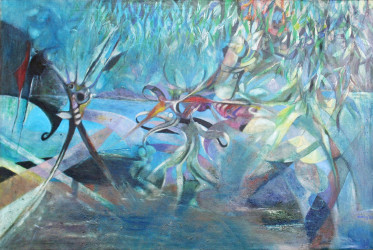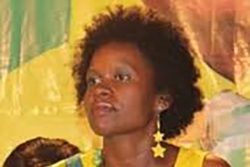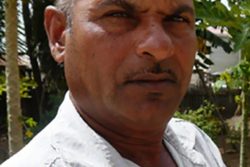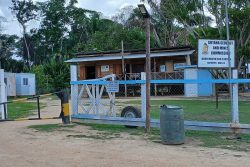In this their sixth conversation, artists Stanley Greaves and Akima McPherson examine Dudley Charles painting, River Spirit. This painting is currently available for viewing at the National Gallery of Art, Castellani House until September 12, 2015.
S.G: River Spirit by Dudley Charles relates to works by other artists exploring Guyanese folklore. His painting does not attempt to create recognisable images. It is this that helps create a sense of mystery. To this end there are two images that seem to contradict one another. The image on the left is almost sculptural in form, the other to the right is more painterly. This helps to produce a sense of drama and tension.

A.M: Yes, I get drawn into the painting because of the form on the left also, what in art vocabulary is
called the focal point – the point that draws the eye into the artwork. I like its strangeness; it looks like nothing to be found in nature. And I like its mystery. It also has very definite edges unlike the other painterly forms to the right, so I see that tension you speak of. And because of the extensions that define the ‘creature’ on the left, my eyes follow these to other parts of the painting.
S.G: Actually, it is the other form near the centre that I find more interesting. It is indeterminate, more mysterious, providing space for the imagination to play. Charles obviously enjoys manipulating paint, working wet into wet to provide hues/colours without premixing them. This provides effects that are not as direct as mixing colours before using them in the painting. The overall effect could be considered expressionistic, appealing to the sense of sight. All in keeping with the theme I would think.
A.M: I see he uses glazing which works well with the theme also.
S.G: Yes, glazing means that you are using transparent layers of colours. Each layer has to be dry before applying the next. It also means that the painting’s ground has to be white to reflect light through the layers. Wet into wet means using opaque colours mixing them on the canvas directly to achieve a spontaneous effect. The brushwork becomes evident. Charles has used both techniques effectively in River Spirit.
A.M: I like Charles’ use of glazing. It allows him to achieve a layered and transparent surface which in turn allows me to think of and see water. The very painterly form to the extreme right appears submerged in water and invokes thoughts of the unknown beneath our darkened river and creek waters. Indeed, this area causes me to recall experiences of being in creek waters with thick foliage on the banks and feeling like I am accompanied by indeterminate forms beneath the water’s surface.
S.G: Indeterminate forms indeed. The river spirit -WATA MAMA of folklore- is a water spirit to which offerings were made by devotees seeking favors of one kind or another. Folkloric practices the world over all seem to have water divinities.
The complexity of Charles’ painting is visually inviting and adds to the mystery of the theme chosen. For viewers not interested in the theme, the work could perhaps even be viewed as an abstract composition to some extent where lines, textures and colours entertain the eye.
River Spirit is a fine example of work by an artist who is in full command of painting techniques used to advantage in exploring his theme.








